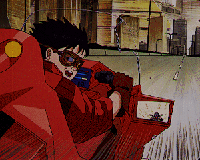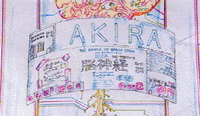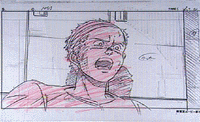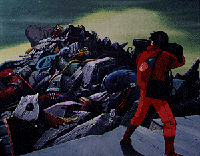

Japan action
1989
color 124 min.
Director: Katsuhiro Otomo
CAV: out-of-print collectible
3 discs, catalog # CC1294L
CLV: out-of-print collectible
2 discs, catalog # CC1435L
Voyager: akira


 There's been a lot of loose talk over the years about "the art of
animation." Here, for once, is an actual specimen -- a work of art
that happens to be animated. Katsuhiro Otomo's Akira doesn't just ape the techniques
of "real movies" without embarrassing itself. The suspense, horror,
awe and exaltation that he invokes are potent by any measure. And
while Otomo does incorporate brief snippets of computer animation in
Akira, he doesn't need a computer to
create a hand-drawn image that we can move through, and around in, and
gape at from every possible angle.
There's been a lot of loose talk over the years about "the art of
animation." Here, for once, is an actual specimen -- a work of art
that happens to be animated. Katsuhiro Otomo's Akira doesn't just ape the techniques
of "real movies" without embarrassing itself. The suspense, horror,
awe and exaltation that he invokes are potent by any measure. And
while Otomo does incorporate brief snippets of computer animation in
Akira, he doesn't need a computer to
create a hand-drawn image that we can move through, and around in, and
gape at from every possible angle.
 Akira is not merely a
technical tour de force. The vast machinery of cells and xerography
and ink-'n'-paint has been harnessed to unified expressive purpose. A
mesmerizing blend of high government conspiracies, teenage angst,
revolution, evolution, and motorcycle gang mayhem, topped off by a
21st-century telekinetic detonation, Akira would be classic science fiction,
and thrilling cinema, even if it weren't animated. Of course, if it
weren't animated, it probably couldn't exist at all -- not at today's
prices.
Akira is not merely a
technical tour de force. The vast machinery of cells and xerography
and ink-'n'-paint has been harnessed to unified expressive purpose. A
mesmerizing blend of high government conspiracies, teenage angst,
revolution, evolution, and motorcycle gang mayhem, topped off by a
21st-century telekinetic detonation, Akira would be classic science fiction,
and thrilling cinema, even if it weren't animated. Of course, if it
weren't animated, it probably couldn't exist at all -- not at today's
prices.
 Otomo creates a demonic
future. Neo-Tokyo was flattened in 1996 when a top secret weapons
experiment backfired: The mad doctors and crazed warriors of the first
Akira Project had wanted to crack open the human mind and
explosively release its untapped energy. It makes perfect sense (as it
did in the Brian De Palma PSI-thrillers Carrie and The Fury) that the
ideal candidates for these brain-fusion experiments would be
adolescents, because their nervous systems are already
turbo-charged. They go through Jekyll-and-Hyde seizures when their
powers begin to erupt, like the standard hormonal crises writ
large. The fireball that engulfs Tokyo comes right out of the forehead
of a twisted street kid. Now a gifted youngster, a put-upon
gang-banger with a raging grudge against the world, has become the
guinea pig of Akira Phase Two. All hell is about to break loose again
-- Apocalypse 2.
Otomo creates a demonic
future. Neo-Tokyo was flattened in 1996 when a top secret weapons
experiment backfired: The mad doctors and crazed warriors of the first
Akira Project had wanted to crack open the human mind and
explosively release its untapped energy. It makes perfect sense (as it
did in the Brian De Palma PSI-thrillers Carrie and The Fury) that the
ideal candidates for these brain-fusion experiments would be
adolescents, because their nervous systems are already
turbo-charged. They go through Jekyll-and-Hyde seizures when their
powers begin to erupt, like the standard hormonal crises writ
large. The fireball that engulfs Tokyo comes right out of the forehead
of a twisted street kid. Now a gifted youngster, a put-upon
gang-banger with a raging grudge against the world, has become the
guinea pig of Akira Phase Two. All hell is about to break loose again
-- Apocalypse 2.
 It's no wonder Otomo insisted
on shooting Akira in 70mm:
Neo-Tokyo, circa 2019 A.D., has been visualized down to the last brush
stroke of graffiti, and every detail is worth seeing. The production
supplement of the Criterion Collection edition shows off the
fine-point precision of Otomo's sketches and storyboard
illustrations. A tavern that figures in only two scenes is envisioned
from its floor plan to the CDs in its jukebox -- even to the inner
workings of the box. The swiveling complexity of an incidental item
like the gyroscopic body-scanner in a secret laboratory, with its
interlocking cylindrical moving parts, goes further. The machine
doesn't need to look that spiffy, and it doesn't need to be half that
complicated. It's been designed to the hilt just for the pleasure of
it, as a high-tech objet d'art.
It's no wonder Otomo insisted
on shooting Akira in 70mm:
Neo-Tokyo, circa 2019 A.D., has been visualized down to the last brush
stroke of graffiti, and every detail is worth seeing. The production
supplement of the Criterion Collection edition shows off the
fine-point precision of Otomo's sketches and storyboard
illustrations. A tavern that figures in only two scenes is envisioned
from its floor plan to the CDs in its jukebox -- even to the inner
workings of the box. The swiveling complexity of an incidental item
like the gyroscopic body-scanner in a secret laboratory, with its
interlocking cylindrical moving parts, goes further. The machine
doesn't need to look that spiffy, and it doesn't need to be half that
complicated. It's been designed to the hilt just for the pleasure of
it, as a high-tech objet d'art.
 As is not uncommon in high-genre exercises, the characters who inhabit
this spangled and trashy new world, from the noble bikers Kaneda and
Tetsuo to the heavy-breathing crypto-fascist Colonel, are
two-dimensional figures -- in more ways than one. But then, the
characters seem to be extensions or agents of the psyche of the city,
which has an overriding destiny of its own. The translation of Akira from comic book to movie, Otomo
says, allowed him to display Neo-Tokyo all at once, as a single huge
entity.
As is not uncommon in high-genre exercises, the characters who inhabit
this spangled and trashy new world, from the noble bikers Kaneda and
Tetsuo to the heavy-breathing crypto-fascist Colonel, are
two-dimensional figures -- in more ways than one. But then, the
characters seem to be extensions or agents of the psyche of the city,
which has an overriding destiny of its own. The translation of Akira from comic book to movie, Otomo
says, allowed him to display Neo-Tokyo all at once, as a single huge
entity.
 Otomo was still almost an
apprentice animator when he made this seductively accomplished
picture. In his early 30s he was one of Japan's most popular creators
of manga -- fat comic books, slapped onto thick newsprint pages in
dynamic diagonals, designed to be read at blistering speeds. (Manga
are not a fringe cult, but a major commercial force: Top titles can
unload six million copies a week, spinning off animated and
live-action TV shows and features, as well as lucrative toy-driven
merchandise.) Otomo was the acclaimed writer and artist of
multi-volume sagas like Fire Ball, Domu, and the
original magazine version of Akira,
reprinted in the States by Marvel's Epic Comics division. Otomo has
made two live-action movies (Give Me a Gun, Give Me Freedom in
1988, and World Apartment Horror in 1991), but his only work in
animation prior to Akira had been a
few short films. Right out of the gate he has redeemed one of the
central promises of animation: its power to conjure up new
worlds.
Otomo was still almost an
apprentice animator when he made this seductively accomplished
picture. In his early 30s he was one of Japan's most popular creators
of manga -- fat comic books, slapped onto thick newsprint pages in
dynamic diagonals, designed to be read at blistering speeds. (Manga
are not a fringe cult, but a major commercial force: Top titles can
unload six million copies a week, spinning off animated and
live-action TV shows and features, as well as lucrative toy-driven
merchandise.) Otomo was the acclaimed writer and artist of
multi-volume sagas like Fire Ball, Domu, and the
original magazine version of Akira,
reprinted in the States by Marvel's Epic Comics division. Otomo has
made two live-action movies (Give Me a Gun, Give Me Freedom in
1988, and World Apartment Horror in 1991), but his only work in
animation prior to Akira had been a
few short films. Right out of the gate he has redeemed one of the
central promises of animation: its power to conjure up new
worlds.
 If movement is the
essence of animation, the essence of Otomo's animation is movement not
so much of figures, but of the camera through space -- swooping around
high-rise monuments bristling with embellishments. It is movement --
specifically, its degree of naturalism -- that is often a sore point
among American cartoon fanciers. Some, steeped in the Disney/Warners
establishment tradition, make a fetish of "complete animation" and
reflexively slag off the so-called "limited animation" of Japan. But
apart from its agile camera moves, the crowning glories of Japanese
animation have always been the boldness of its concepts and the
visceral grandiosity of its designs. The animation in Akira is fuller than usual for Japan
(Otomo, too, is a Disney fan), but what matters most is that his feast
of visual ingenuity has real heat and passion behind it. The
hallucinations that terrorize poor Tetsuo late one night, as his
transformation is kicking in, look and feel authentic, like nightmares
we could really suffer through. A taste of reality like that, a flash
of earned empathy, is a more promising step for animation than all the
technical artifice in Toontown.
If movement is the
essence of animation, the essence of Otomo's animation is movement not
so much of figures, but of the camera through space -- swooping around
high-rise monuments bristling with embellishments. It is movement --
specifically, its degree of naturalism -- that is often a sore point
among American cartoon fanciers. Some, steeped in the Disney/Warners
establishment tradition, make a fetish of "complete animation" and
reflexively slag off the so-called "limited animation" of Japan. But
apart from its agile camera moves, the crowning glories of Japanese
animation have always been the boldness of its concepts and the
visceral grandiosity of its designs. The animation in Akira is fuller than usual for Japan
(Otomo, too, is a Disney fan), but what matters most is that his feast
of visual ingenuity has real heat and passion behind it. The
hallucinations that terrorize poor Tetsuo late one night, as his
transformation is kicking in, look and feel authentic, like nightmares
we could really suffer through. A taste of reality like that, a flash
of earned empathy, is a more promising step for animation than all the
technical artifice in Toontown.
-- DAVID CHUTE


Index of Films

 
View Items |
Checkout
Ordering Information |
Criterion |
Home Vision
|
|

|






